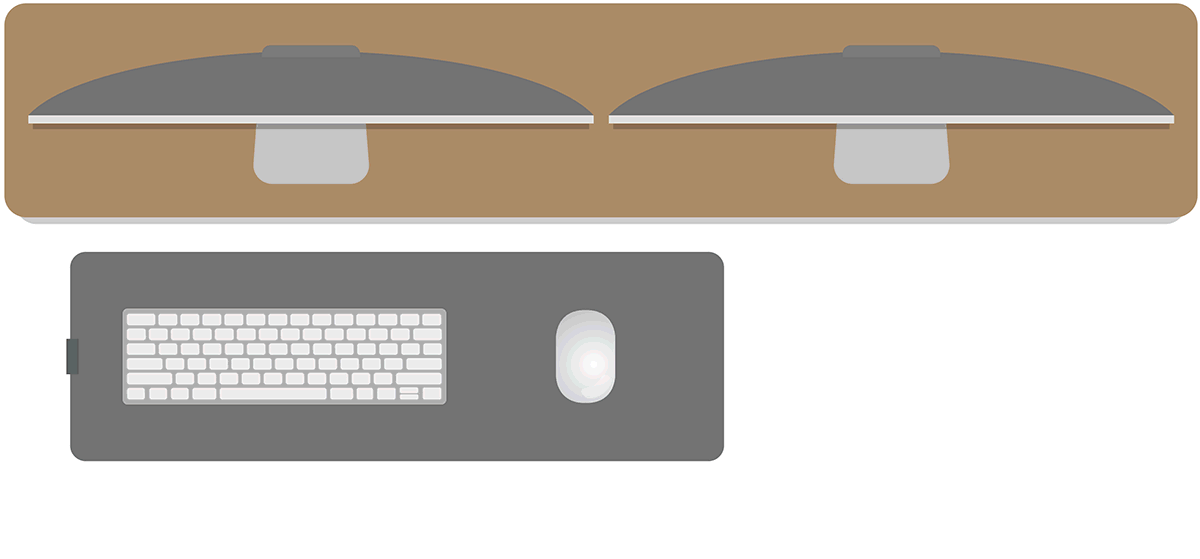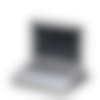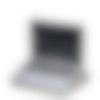Designing the Desk Shelf System - Part Two
Back in the design studio after cruising all over Portland to look at workspaces, Ken and Sean worked to create a complete system for your desk.
In Part One
Ken and Sean visited over 600 desks, at 11 offices all across Portland. The goal was to learn what people needed at their workspace, and we decided to tackle it head on by visiting and observing. We observed that people needed a solution for multiple screens. The workspace was evolving, so we decided to design something totally new to suit it.
Ken had built some rough prototypes and physical ideas in the shop, mostly settling on a simple shelf concept. Sean made an initial pitch to use cork for the legs—only to be denied on account of the cork not looking very good.
Ken had built some rough prototypes and physical ideas in the shop, mostly settling on a simple shelf concept. Sean made an initial pitch to use cork for the legs—only to be denied on account of the cork not looking very good.
The Legs
Sean was convinced that cork could work for the legs, it was just a matter of pushing the aesthetic possibilities a bit.
Cork comes in a wide variety of grains, which has a significant impact on how it looks. Sean researched an alternative source for finer grained cork, and he incorporated a metal plate into the middle of the leg. He presented his findings to Ken, and it got the thumbs up. Cork it was!

SEAN KELLY: Once I got the ok to go for the cork and metal legs, I had to figure out how to blacken the cork, to go with the Walnut shelf. Another task in itself!

Sean figured out that the best way to get the rich, black color we wanted was to use Sumi ink, a traditional ink used in Japanese calligraphy.
The cork legs also helped with a major hurdle—shipping costs. The desk shelf was the largest product we’d ever developed, and we needed to find a way for it to ship flat. The lightweight cork legs were easy to assemble (no tools needed) and made for a much more cost-effective shipping method.
But questions about the legs still lingered. How many legs would we need? Would there be multiple potential orientations, or one set conformation? Would the legs incorporate additional functions?
But questions about the legs still lingered. How many legs would we need? Would there be multiple potential orientations, or one set conformation? Would the legs incorporate additional functions?
Simplicity vs Modularity
Adding features to a product is always a slippery slope. It’s easy to go too far. The more features you add, the more complicated, expensive, and less focused the product becomes. Designing something that’s simple and well done is way more satisfying than one that has 80 features, none of which are totally dialed in. So, we always strive for simplicity in our designs. Functional, but focused. We believe that you create a better product when you resist the temptation to add too many features.
The desk shelf is a great example of this philosophy in action. Sean created multiple high-level concepts, all outlining different directions we could take the product. One had numerous leg slots, to allow the user to customize the orientation and spacing of the legs. It was very modular. Another concept had a cord-organizing leg with a hole in the middle. And, we considered a simple concept, with three fixed leg positions, providing stability without complicating things. After discussing each, we opted for the simple three-legged version. It creates subtle zones for organizing, and the assembly is simple and straightforward. It’s not customizable, it doesn’t solve every problem, but we think it’s the best solution we could design in a single coherent product.



"We know everyone works differently, so the workspace solutions have to account for that with flexibility. It’s not modular, but the simplicity creates flexibility."
SEAN KELLY
Lead Product Designer

The system was starting to take shape: The large upper shelf for your monitors, legs for an ergonomic boost, and a smaller shelf designed to store your tablet or laptop when closed.
The workspaces we had observed were so varied, we realized that our shelf alone wouldn’t solve all workspace organization problems. So, we continued to design!
The workspaces we had observed were so varied, we realized that our shelf alone wouldn’t solve all workspace organization problems. So, we continued to design!
A Tray for Your Things
Sean had mocked up a bent metal paper tray concept a while ago, and we brought it back to the design table to see if we could give it more organizational capabilities. From our research we noticed that almost everyone has file cabinet-like solutions in their workspace, usually below the desk, but they rarely use them! They might throw stuff under there from time to time, but they’re not a part of actual work.
Use it how you like, use it how you need to—making the product simple makes it better.
Our first pass involved studying an integrated drawer design, fixed between two of the desk shelf legs. As we considered it, we realized that a drawer would restrict the flexibility of the desk shelf. If we integrated a directional drawer, only one shelf orientation would work, with the legs on the right. We believed that added flexibility was more important.
Additionally, the drawer design would have been more expensive, due to additional hardware and engineering. Integrating it directly with the desk shelf would have made the whole product more expensive than we were comfortable with!
So we nixed the drawer concept and focused on a tray. Sean studied and created a variety of machined cork pockets, settling on a simple set to hold the things you most often keep at your desk. The tray is designed to slide neatly under the integrated metal shelf, but works just as well on its own, resting on a table or desk completely separate from the desk shelf. It’s a supplemental piece that can help your workflow—making the product simple makes it better and more versatile.
Additionally, the drawer design would have been more expensive, due to additional hardware and engineering. Integrating it directly with the desk shelf would have made the whole product more expensive than we were comfortable with!
So we nixed the drawer concept and focused on a tray. Sean studied and created a variety of machined cork pockets, settling on a simple set to hold the things you most often keep at your desk. The tray is designed to slide neatly under the integrated metal shelf, but works just as well on its own, resting on a table or desk completely separate from the desk shelf. It’s a supplemental piece that can help your workflow—making the product simple makes it better and more versatile.

Bulldoze No More
We noticed an interesting behavior when we’d visited offices around town—when people switched from working digitally, like sending emails, to something analog, like sketching or taking notes, they had to bulldoze everything on their desk off to the side. It was an obvious pain point.

We realized that the large ‘garage’ space under the shelf would be the perfect space to stow your keyboard and mouse when you needed to clear desk space—and, what if you could slide everything under by moving the smaller version of our desk pad, sized just right to slide between the shelf legs? A magic carpet for your desk, and an end to bulldozing your things!
KEN TOMITA: The fact that you can tidy up the whole desk surface with a simple motion is awesome. I use the pad all the time. Slide it out of the way to make room for sketching or writing.


A Lift for Your Laptop
The hardest piece of the system to design was actually the laptop lift.
We designed the original laptop stand for someone who worked exclusively on their laptop, with a separate keyboard and mouse. But, through our research, we’d observed that the laptop was often only one of multiple screens people would use. Going to and from meetings or traveling, they’d take the laptop with, leaving the laptop stand exposed on the desk.
We designed the original laptop stand for someone who worked exclusively on their laptop, with a separate keyboard and mouse. But, through our research, we’d observed that the laptop was often only one of multiple screens people would use. Going to and from meetings or traveling, they’d take the laptop with, leaving the laptop stand exposed on the desk.

We saw two design problems here: how to raise the laptop screen for ergonomics and workflow, and how to make a laptop stand that looked appealing even when the laptop wasn’t there. Additionally, we wanted to create a solution that allowed for direct typing.
Sean worked through various explorations using bent metal to create a pretty, and pretty radical, solution.
Sean worked through various explorations using bent metal to create a pretty, and pretty radical, solution.


Sean went back and forth forever with our vendor, but despite our best efforts, the full metal version was going to be way too expensive. Sean got creative. Using a cork base simplified the overall manufacturing, simplified the metal bending, and allowed us to make the laptop lift at a more reasonable price point.

"Ironically, the laptop lift alone ended up taking about 80% of the total time we spent designing the desk shelf system. We have to push our designs to match our expectations, but also what’s feasible to produce in real life."
SEAN KELLY
Lead Product Designer
He integrated the stop design we’d created for the laptop stand, and used wool felt as a soft surface, providing a nice visual contrast to the wooden shelf top. It could sit on the top of the shelf, or function solo on a flat desk surface, typed on directly.
All At Once
The whole desk shelf system started with you, our fans and customers. We set out to create something functional and beautiful that would make your workspace better. We love how the pieces all came together to solve problems we observed in real workspaces.
Thanks for the inspiration—we’re excited to keep listening and learning, to help make your workspace somewhere where you can get your best work done!
Thanks for the inspiration—we’re excited to keep listening and learning, to help make your workspace somewhere where you can get your best work done!
Meet the Players
Each piece is available individually, allowing you to mix and match to dial in your desk.

















































